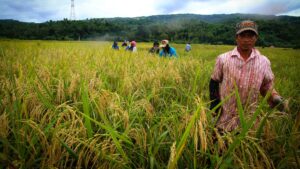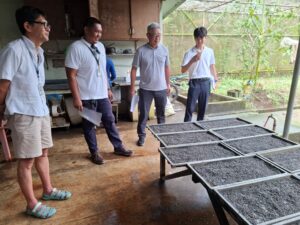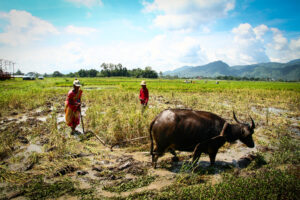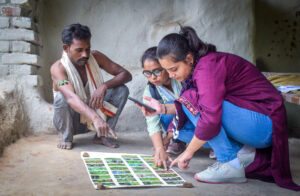Soil is the most important natural resource after water and oxygen for life on Earth. Soil is the foundation of our food system. Our planet’s as well as each our own survival depends on soil as over 95 percent of our food originates from it. However, in the face of climate change and human activities, soils around the globe are being degraded through excessive agricultural practices that negatively impact its health.
To paint a picture of the extent of soil consumed by human activity: 1.6 billion hectares were dedicated to cropland worldwide in 2022. This is roughly equivalent to the land area to cover Russia (1.7 billion hectare) or South America (1.8 billion hectare). All agricultural lands, including farms and pasturelands, arrive at 4.8 billion hectare—2.7 to 2.8 times the size of Russia or South America, respectively. In other words, the amount of soil required to feed the world—an effort we are still falling short of—is enormous.
What is soil?
Soil is composed of roughly half water and air, while the other half is mostly inorganic materials, along with a smaller proportion of organic matter. The inorganic components stem from rocks that have broken down into ever so smaller particles. Meanwhile, the organic matter—both living and dead—is what makes soil fertile. It is this composition that forms the proverbial ground for storing and supplying nutrients to plants.
Soil organic matter consists of living and dead biomass, such as microorganisms (fungi, protozoa, algae, and more), plant matter, animals and insects. The range of organisms in soil is estimated to represent about 25% of the world’s biodiversity alone. Living microorganisms and insects feed on and recycle organic residues in soil, and in the process mix organic matter with the mineral components of the soil. The process also helps improve water infiltration and aeration which in turn stabilizes the soil composition.
In that decomposition process, encompassing plant and animal residues, humus is formed. Humus is the dark material that remains after most of the organic matter has broken down. When organic materials are either fully or partially disintegrated, the resulting humus stores essential nutrients, releasing them over time for plant uptake. It is important for land conservation as it reduces rain runoff or irrigation water outflow, for example, in sandy soil, as well as soil compaction problems that occur, such as in clay soil. As soil rich in humus acts like a porous sponge, it can reduce, if not prevent, the spread of chemical substances added to the ground.
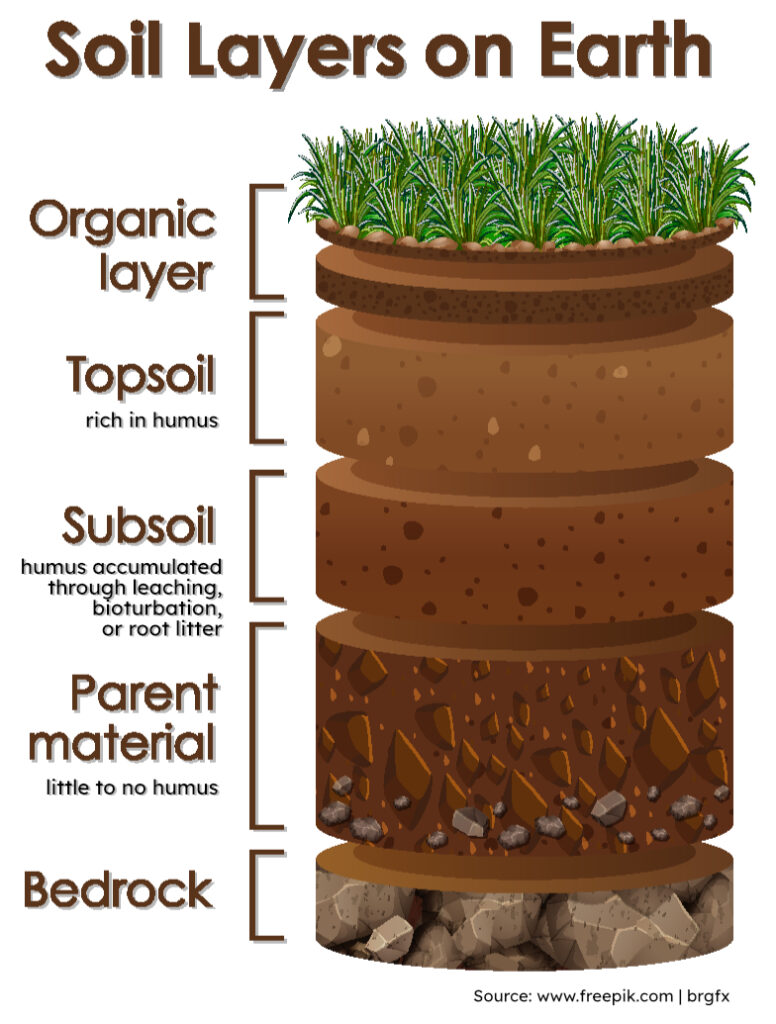
Rice soil requires dedication
Out of the 1.6 billion hectares of cropland worldwide, only 10.3% or 165 million hectares are attributed to rice farming. Out of those 165 million, Southeastern, Southern, and Eastern Asia cover 142 million hectares or about 86% of the world’s rice soils. For comparison, that would be the size of Mongolia (141 million hectares) required for rice cultivation. It goes without saying that rice cultivation depends on healthy soils, too.
Healthy soils filter water, immobilize toxic substances, mineralize residues, store carbon, and exchange gases with the atmosphere. However, these properties are under stress in rice soils, as fields are flooded, plowed, rotovated, and tilled (or puddled) to prepare the land. Rice soil requires specific attention to retain its nutrient and structural properties, as the same soils are meant to produce typically two, if not three, harvests in a one-year period.
Soil quality can be negatively impacted by intense cultivation, excessive use of chemical fertilizers and pesticides, removal of crop residues, and the use of low-quality irrigation water. These practices can lead to either nutrient depletion or over-saturation with trace minerals, such as nitrates or sodium bicarbonate, among others. Additionally, such practices can cause soil structural deficiencies, such as compaction.
With the International Rice Research Institute (IRRI) working on improving rice production through tried-and-tested scientific means, soils are an inseparable part of sustainable rice farming practices. Improving rice farming aimed at productivity optimization, greenhouse gas emission reductions, and chemical fertilization replacement goes hand in hand with protecting the soil where rice is grown.
IRRI promotes the sustainable management of soils directly or indirectly through practices such as Site-Specific Nutrient Management, Alternate Wetting and Drying, and on-field Rice Straw Management.

How does alternate wetting and drying benefit soil conditions?
Alternate Wetting and Drying (AWD) is a water-saving practice that farmers can apply to reduce their irrigation water consumption. With AWD, water levels in rice fields are left to dry 15cm below the soil surface before re-flooding the soil—hence, alternating between wet and dry. The number of days between irrigation can vary from one to more than ten, depending on the soil type, weather, crop growth stage, and other cultivation factors.
Improved Soil Conditions. By periodically drying the soil, AWD increases oxygen levels in the root layer of the soil. The improved aeration enhances root growth and nutrient uptake. Periodic drying also reduces nutrient loss through denitrification and leaching, improving nutrient use efficiency.
Enhanced Microbial Activity. Fluctuations in soil moisture create favorable conditions for soil micro-organisms that require oxygen. Without standing water, microorganisms decompose organic matter more efficiently, release nutrients, and suppress soil-borne pathogens.
Reduced Greenhouse Gas Emissions. By reducing water use and allowing for dry soil conditions, AWD decreases methane production in flooded rice fields under low-oxygen (anaerobic) conditions. Methane significantly contributes to greenhouse gas emissions, with exponential warming potential compared to carbon dioxide.

How does site-specific nutrient management benefit soil conditions?
Site-specific nutrient management (SSNM) is a set of principles for optimally supplying rice soil with essential nutrients based on specific conditions. It allows rice farmers to tailor their nutrient management to the specific conditions of their field and provides a framework for supplying optimum amounts of nutrients at critical time points in the crop’s growth to produce high yields.
Optimized Nutrient Application. By tailoring nutrient applications to specific field zones, SSNM reduces the risk of over-fertilization, which can otherwise lead to nutrient leaching and pollution of water bodies. Precise nutrient application also ensures that crops receive the amount of nutrients they need, minimizing nutrient loss and maximizing uptake.
Reduced Chemical Input. By optimizing nutrient application, SSNM reduces the overall quantity of fertilizer required, leading to a lower farm management cost, higher profit, and a reduced environmental impact. It also reduces greenhouse gas emissions as a more efficient use of nitrogen reduces nitrous oxide emission from the field, as well as indirect emissions by reducing the need for producing nitrogen fertilizer.
Minimized Pesticide Use. By providing optimal nutrition, SSNM can reduce the need for chemical pesticides because healthy crops are less susceptible to pests and diseases, which in turn promotes more sustainable rice cultivation.

How does rice straw management benefit soil conditions?
Straw management of rice is distinguished between two different aspects: the management of straw off the field and its management on the field (off-field and on-field). For soil, on-field management of rice straw is most important as maintaining the straw on the field – or in the soil – allows for breaking down organic matter into soil nutrients. On-field management typically refers to burning of straw residue or incorporating the straw into or onto the soil. The burning of straw has been acknowledged as detrimental to human health as it causes toxic air pollution and should therefore not be practiced.
Soil Matter Enrichment. Rice straw, when incorporated into the soil, enhances soil structure, increasing its water-holding capacity and aeration. As it decomposes, it releases a range of essential nutrients (trace minerals), such as nitrogen, silica, phosphorus, potassium, magnesium, calcium and sulfur. The improved soil structure and release of nutrients promotes root growth and nutrient uptake.
Suppressed Weed Growth. Keeping a layer of rice straw like a blanket on the soil surface can suppress weed growth during drying period of rice fields and directly after harvesting. By suppressing weeds, the straw blanket reduces competition for nutrients and water with the main crop.
Increased Soil Biodiversity. Reintegrating straw or maintaining a blanket during extended dry periods stimulates microbial and insect life that feeds on the organic matter, as described earlier, and in turn produces humus, serving as a nutrient sponge and limiting soil compaction.
Greenhouse Gas Emissions. By incorporating rice straw into the soil, rice soil is more likely to produce methane emissions if and when the straw’s organic matter decomposes under anaerobic conditions. However, in combination with Alternate Wetting and Drying, this effect can be minimized as the soil becomes aerated. In addition, incorporating the straw sequesters carbon in the soil – as opposed to burning it into the atmosphere.
Don’t take soil for granted
World Soil Day is held annually on 5 December as a means to focus attention on the importance of healthy soils and to advocate for the sustainable management of soil resources. Under the leadership of Thailand and within the framework of the Global Soil Partnership, the Food and Agricultural Organization has supported the formal establishment of the World Soil Day as a global awareness raising initiative. In December 2013, the UN General Assembly responded by designating 5 December 2014 as the first official World Soil Day.
Sustainable soil management practices, such as minimum tillage, crop rotation, organic matter addition, and cover cropping, improve soil health, reduce erosion and pollution, and enhance water infiltration and storage. These practices also preserve soil biodiversity, improve fertility, and contribute to carbon sequestration, playing a crucial role in the fight against climate change.
Healthy soil is defined by its ability to function efficiently both today and in the future—aligning with the principles of sustainability. However, soil health is often difficult to observe. Rice soils require specific attention because they differ from drained crop soils due to their flooded conditions, which alter the way nutrients become available. Assessing soil composition changes over time can be achieved by using soil quality indicators that focus on physical, chemical, and biological aspects. The International Rice Research Institute is prepared to provide technical and methodological guidance on rice production and maintaining healthy soils.
Are you looking to increase your knowledge or build capacity among colleagues, teams, or peers?
IRRI provides online learning modules tailored to various aspects of rice farming, from land preparation to post-harvest approaches, including on Alternate Wetting and Drying, Site-Specific Nutrient Management or Rice Straw Management.

